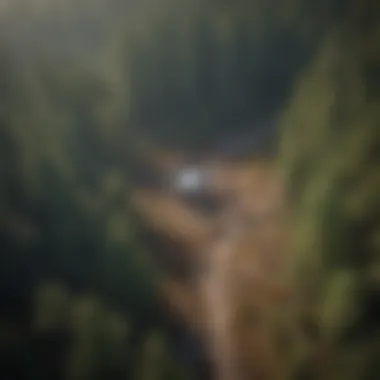Understanding Drone Legislation in Forestry Management


Intro
Drone technology has reshaped many industries, and forestry management is no exception. As drones become more accessible and capable, they play a pivotal role in monitoring and managing forests. However, their use summons complex legal considerations that forestry professionals must navigate. Understanding the regulations connected with drone usage in forestry not only ensures compliance but also facilitates sustainable practices. This article will provide information on the legal landscape surrounding drones in forestry, emphasizing the significance of responsible usage for both ecosystem health and regulatory adherence.
Overview of Forestry Practices
Forestry practices encompass a broad array of activities focused on the stewardship and utilization of forest resources. The importance of forestry extends beyond economic benefits. Forests serve as crucial ecosystems that maintain biodiversity, regulate climate, and support livelihoods worldwide. As we examine forestry practices, it is paramount to grasp their relevance to the environmental challenges we face today.
Importance of Foresting
Forests play a significant role in carbon sequestration, helping to mitigate climate change impacts. They also provide habitat for wildlife and preserve watershed health. Economically, the forestry sector contributes to local and national economies through timber production, recreation, and tourism. Protecting and managing these vital resources creates a balance between human needs and ecological integrity.
Types of Forestry Practices
Forestry practices can be categorized into various types, each with distinct approaches and goals:
- Sustainable Forestry: Focuses on maintaining ecological balance while fulfilling economic needs.
- Agroforestry: Combines agriculture and forestry for improved land productivity and sustainability.
- Clearcutting: Involves the complete removal of trees in a designated area, often criticized for environmental impact.
- Selective Logging: Harvests only specific trees, minimizing disturbance to the ecosystem.
By recognizing these practices, forestry professionals can understand better how drone technology can assist in monitoring and enforcing compliance with legal standards.
Best Practices for Sustainable Woodland Stewardship
To ensure forests remain robust and resilient, sustainable woodland stewardship is essential. This concept is not just about the responsible management of resources; it extends to the integration of community values and ecological knowledge into management practices.
Principles of Sustainable Forestry
Sustainable forestry is rooted in several principles:
- Resource Conservation: Prioritizing the careful use of resources supports the longevity of forest ecosystems.
- Biodiversity Emphasis: Protecting diverse species and habitats fosters ecosystem resilience.
- Community Involvement: Engaging local stakeholders ensures practices are socially and ethically accepted.
Techniques for Land Management
Effective land management techniques also play a crucial role:
- Controlled Burns: Used to reduce fuel load and promote the growth of fire-adapted species.
- Reforestation: Planting trees in deforested areas restores ecosystems and enhances carbon uptake.
- Monitoring and Assessment: Utilizing drones to carry out detailed assessments of forest health and biodiversity.
These techniques highlight where drones can enhance management strategies by providing valuable data and insights, allowing for timely interventions.
Innovative Techniques in Forestry
Innovations in forestry offer new methodologies for ecological management. Traditional practices can now be complemented or transformed by modern technologies, creating a holistic approach.
Latest Technological Advancements
Cutting-edge technologies in forestry include high-resolution imaging, LiDAR, and drone applications. Drones can cover vast areas in a fraction of the time of traditional methods. They gather data on forest structure, health, and composition, which is invaluable for forest management.
Integrating Traditional Knowledge with Modern Science
The fusion of traditional ecological knowledge with technological advancements creates a well-rounded perspective on land management. Local wisdom combined with accurate data from drones ensures management practices are both culturally relevant and scientifically sound. This integration helps to tailor forestry strategies to specific regional needs and enhances overall sustainability.
"The intersection between technology and ancient knowledge can provide remarkable insights into our environment."
As we move forward in understanding drone legislation within the forestry sector, it becomes clear that utilizing these practices responsibly is not just necessary—it's imperative for the survival and health of global forest resources.
Intro to Drone Legality


The topic of drone legality is crucial in the context of forestry management, where both technological advancement and environmental stewardship intersect. Drones offer significant benefits, enhancing efficiency in tasks such as mapping forests, monitoring ecosystems, and managing wildlife. However, as with any emerging technology, they come with legal and regulatory challenges that must be navigated carefully.
Definition and Importance
Drones, also known as unmanned aerial vehicles (UAVs), are aircraft that operate without a human pilot onboard. Their importance in forestry management cannot be overstated. By providing aerial data collection and monitoring capabilities, drones improve decision-making processes, reduce costs, and enhance operational efficiency.
Understanding the legal landscape surrounding drones ensures compliance with regulations, which is essential for legal operation in forestry. Forestry professionals who grasp these legalities are better equipped to use drones effectively while minimizing the risk of penalties or fines.
Historical Context
The use of drones in various industries, including forestry, has evolved significantly over the past decade. Initially, the deployment of UAVs was limited due to regulatory uncertainties and technological limitations. Early adopters faced various challenges, from obtaining permission to fly to navigating airspace restrictions.
Over time, advancements in drone technology and growing recognition of their potential led to the development of more structured regulatory frameworks. Initial regulations varied widely among countries and often lagged behind technology's rapid evolution. In recent years, agencies like the Federal Aviation Administration (FAA) in the United States have implemented clearer guidelines, prompting a more standardized approach to drone usage in forestry.
This historical backdrop highlights the ongoing need for knowledge of drone legislation, as it continues to shape how drones are utilized for sustainable forest management practices. Knowledge of past and current regulations is essential for those in the forestry industry to harness the full potential of drone technology.
Regulatory Frameworks for Drones
Understanding the regulatory frameworks for drones is essential in the context of forestry management. These frameworks govern how drones can be used, outlining the legal boundaries and ensuring that operations are conducted safely and ethically. With the increasing application of drone technology in monitoring ecosystems and managing forest resources, clear regulations are crucial. The benefits of a robust regulatory framework include enhancing operational efficiency, ensuring compliance with environmental laws, and fostering accountability among operators. Moreover, they help to mitigate potential conflicts with civil aviation regulations and protect wildlife habitats.
Overview of National Regulations
National regulations for drones vary widely across countries. In the United States, for instance, the Federal Aviation Administration (FAA) creates the guiding principles. These include requirements for registering drones, obtaining pilot licenses, and adhering to specific altitude and distance restrictions. In several European Union (EU) nations, the European Union Aviation Safety Agency (EASA) has implemented stringent rules that prioritize safety and privacy. There are also unique regulations in countries like Canada, where Transport Canada outlines operational guidelines that must be followed. The importance of adhering to national regulations cannot be overstated; failing to comply can result in fines, confiscation of equipment, or even criminal charges.
State and Local Laws
In addition to national regulations, state and local laws further complicate the landscape of drone usage. Each state in the U.S. may have its own set of laws that govern drone activities. For example, some states enact laws that limit the use of drones in agricultural settings or near specific wildlife habitats. Local municipalities often introduce ordinances that dictate where drones may be flown or how they can be used. Understanding these local regulations is imperative for forestry professionals, as they can significantly affect operational capabilities. Operators should consult local guidelines to ensure all activities fall within legal frameworks, as ignorance of state and local laws is not a defense against enforcement actions.
International Standards
Internationally, there are a few efforts towards creating unified standards for drone operations. Organizations like the International Civil Aviation Organization (ICAO) work to establish guidelines that member states can adopt. Such standards address issues of airspace integration and environmental impact. However, the challenge remains that many countries have different priorities and approaches. This disparity can lead to complications for forestry professionals who operate across borders. Compliance with international standards holds the potential to improve safety, especially in regions where drones are increasingly used for environmental monitoring and conservation efforts. The future may see greater harmonization, but professionals must stay informed about the varying international standards to avoid legal pitfalls.
It is essential for forestry management professionals to be aware of both national and local regulations to ensure compliance and promote sustainable practices.
Drone Uses in Forestry Management
The integration of drones within forestry management has emerged as a pivotal element in optimizing practices related to land use and sustainable forestry. By harnessing aerial technology, forestry professionals can improve their strategies and make informed decisions. Drones provide effective tools for mapping, monitoring ecosystems, and managing wildlife populations.
Specifically, they facilitate real-time data collection, which is essential for sustainable practices. The adoption of drone technology is not only about efficiency but also about enhancing accuracy. Understanding the applications of drones in forestry is imperative for those involved in environmental conservation and resource management.
Mapping and Surveying
Drones excel in mapping and surveying large forested areas with remarkable precision. Unlike traditional methods, which can be time-consuming and labor-intensive, drones allow for rapid data acquisition with minimal human intervention. This capability is crucial for creating detailed topographical maps and assessing land use changes over time.
Utilizing drones equipped with high-resolution cameras and LiDAR sensors enables forestry managers to gather extensive aerial imagery. The resulting maps provide critical insights into forest density, vegetation health, and potential sites for conservation or harvesting.
- Benefits of Drone Mapping:
- Speed and efficiency in data collection.
- High-resolution imagery that captures minute details.
- Cost reduction compared to traditional surveying methods.
In addition, drone mapping can identify areas affected by disease, pests, or weather events, allowing for timely intervention.
Ecosystem Monitoring
Ecosystem monitoring is vital for ensuring the health and sustainability of forested areas. Drones enhance this monitoring process by providing a bird’s-eye view of the environment, revealing changes that might go unnoticed from the ground.


With advanced sensors, drones can collect data on temperature, humidity, and other environmental factors, facilitating ongoing assessments of ecosystem health. Additionally, the ability to conduct frequent flyovers means that forestry professionals can track changes in real-time, leading to quicker response times in addressing ecological threats.
- Key aspects of Ecosystem Monitoring:
- Continuous assessment of forest health.
- Early detection of ecological disturbances.
- Improved management strategies based on accurate environmental data.
"Drones are changing the landscape of forestry monitoring, allowing for more proactive management and quicker responses to threats to ecosystems."
Wildlife Management
The application of drones in wildlife management presents unique opportunities to monitor and manage animal populations within forested areas. Drones can be employed to conduct surveys, tracking wildlife movement patterns and behaviors without disturbing their habitats. This non-intrusive method is essential for gathering data on species that are endangered or elusive.
Moreover, researchers can use thermal imaging cameras mounted on drones to identify wildlife presence at night, offering insights into nocturnal behavior. This is particularly important for understanding habitat use and population dynamics among various species.
- Considerations in Wildlife Management:
- Non-intrusive observations reduce stress on wildlife.
- Enhanced data collection capabilities for better population studies.
- Support for conservation efforts through accurate tracking of species.
In summary, the application of drones in forestry management serves as a key component in modern practices. By adopting drone technology, forestry professionals can significantly improve mapping, ecosystem monitoring, and wildlife management, leading to more informed and effective resource management strategies.
Compliance and Best Practices
Compliance and best practices in drone usage for forestry management cannot be understated. Adhering to regulations minimizes risks associated with drone operations, ensures safety, and promotes sustainable practices. Engaging in compliance fosters trust among stakeholders and the community by demonstrating responsible use of technology.
Registering Drones
Registering drones is a fundamental step for any operator, particularly in the context of forestry management. This process is often mandated by national regulations.
- Registration creates a legal framework for drone operations.
- It assists in identifying the operator in case of an incident.
- Failure to register can lead to fines and operational restrictions.
In the United States, for instance, the Federal Aviation Administration (FAA) requires all drones weighing over 0.55 pounds to be registered. The registration process is relatively straightforward: operators fill out an online form, pay a small fee, and receive a registration number to display on their drone. This ensures operators can be held accountable for their actions.
Pilot Certifications
Pilot certifications are crucial for ensuring that drone operators possess the necessary skills and knowledge to operate safely and efficiently, especially in forestry applications. The certification process often involves specific training and testing.
- Having certified pilots means safer operations.
- Certifications can increase the credibility of the operators.
For example, in the United States, remote pilot certificates require passing a knowledge test on regulations, airspace, and safety procedures. Many other countries have similar requirements. Operators without certifications risk penalties and put their operations in jeopardy, particularly when managing sensitive ecosystems.
Operational Guidelines
Operational guidelines encompass the best practices operators should follow during drone flights, promoting safety and compliance. These guidelines also enhance the effectiveness of the technology in forestry management.
Key operational guidelines include:
- Pre-flight checks: Operators should inspect drones for any mechanical issues before flights.
- Flight plans: Developing a flight plan that considers no-fly zones and weather conditions ensures safer operations.
- Monitoring: Continuous monitoring of drone flights helps in swift reactions to any issues that arise.
- Data management: Proper handling of collected data ensures compliance with privacy regulations and enhances the value of the information.
Legal Consequences of Non-Compliance
Understanding the legal consequences of non-compliance is crucial for anyone engaged in drone operations within forestry management. Failure to comply with relevant regulations can yield significant repercussions not only for individuals and organizations but also for the environments they manage. Compliance ensures that forestry practices uphold sustainability and protect ecosystem health. This section outlines the repercussions related to fines, penalties, and liabilities, clarifying the risks that arise from neglecting regulatory frameworks.
Fines and Penalties
Drones must operate within legal parameters set by national and local authorities. When operators disregard these regulations, they risk facing serious fines and penalties. These consequences can vary dramatically based on the severity of the violation and jurisdiction.


- Monetary Fines: Operating without necessary permissions may attract monetary fines. Depending on the jurisdiction, these can range from a few hundred to several thousand dollars, escalating for repeated offenses.
- Civil Penalties: Besides direct fines, violators might face civil penalties, which can include damage payments or restitution.
- Criminal Charges: In severe cases, especially those involving reckless drone operation causing harm or endangering lives, criminal charges can be filed. Convictions may lead to incarceration or much larger financial penalties.
The financial implications alone underscore the necessity for compliance. Engaging in illegal drone operations not only impacts the operator but can affect community perception of drone usage in forestry as beneficial and responsible.
"Regulatory frameworks are designed not only to enhance safety but also to ensure sustainable practices are maintained."
Liabilities in Forestry Applications
Liabilities connected with drone operations in forestry can be extensive. Non-compliance leads to various forms of liabilities that may include:
- Environmental Damage: Forestry applications using drones might inadvertently cause harm to surrounding ecosystems. Operators can be held accountable for any ecological damage linked to their operations.
- Property Damage: Drones malfunctioning or colliding with property can lead to liability for damages. The drone operator may be responsible for repair costs as well as other associated expenses.
- Insurance Implications: Many insurance policies require compliance with legal regulations. So, failure to adhere to these can put operators at risk of denial of claims in case of an accident.
By understanding these liabilities, forestry professionals can better navigate the complexities of drone operation. It is essential that operators remain aware of the evolving regulations and ensure that their practices are consistently in alignment. Responsible operation of drones not only minimizes risks but also enhances the reputation of drone usage in sustainable forestry management.
Ethical Considerations and Environmental Impact
In the context of forestry management, understanding the ethical implications and environmental impacts of drone usage is essential. As drones integrate into this field, professionals must reflect on the balance between technological advancements and ecological preservation. Ethical considerations encompass not only how the technology is deployed but also the broader consequences its use may impose on natural ecosystems, local communities, and the ethical responsibilities of those operating the drones.
Balancing Technology with Nature
Drones enhance efficiency in forestry management through capabilities like mapping, surveying, and monitoring. However, this increase in efficiency raises questions regarding their impact on wildlife and habitats. For instance, the introduction of drones in sensitive environments can disturb wildlife and disrupt natural behaviors.
To address this, it becomes crucial to develop regulations that prioritize ecological integrity. Adopting practices such as using drones in non-intrusive ways can mitigate negative effects. This includes using thermal imaging for monitoring without physically entering habitats that could disturb wildlife. Furthermore, drone operators should understand the specific ecosystems they are interacting with, recognizing seasonal patterns and breeding cycles to minimize disturbances.
Community Engagement and Outreach
The successful integration of drones into forestry management also relies on the support from local communities. Community engagement plays a critical role in ensuring that drone applications meet societal needs while respecting traditional practices and local knowledge. Outreach programs that involve community members can foster more inclusive decision-making processes and increase awareness of drone capabilities and limitations.
Educating the public helps demystify drone technology. Workshops and demonstrations can illustrate practical uses in forestry while addressing concerns regarding privacy and environmental safety. By facilitating open dialogues, forestry professionals can build trust and gather valuable feedback on how drone technology can coexist harmoniously with community values.
Drones provide significant advantages in forestry management, but ethical considerations are paramount to ensure a sustainable balance between technology and nature.
Future of Drone Legislation in Forestry
The future of drone legislation in forestry is a significant topic, as it will shape how technology is integrated into forest management. With the increasing use of drones, understanding potential changes in regulations is crucial for forestry professionals. This section addresses key elements that could influence future drone legislation. The intersection of technology, environment, and law creates a complex landscape that requires careful navigation.
As drones continue to evolve, they are expected to enhance forestry practices. This includes improving data collection methods and promoting efficient resource management. Future legislation could reflect these advancements, potentially providing frameworks that encourage innovation while ensuring environmental protection.
Additionally, legal considerations must adapt to emerging technologies. This ensures that ethical use of drones aligns with environmental sustainability. Stakeholders must engage in discussions regarding how drones impact ecosystems, and how regulations can safeguard against misuse. Building a harmonious relationship between innovation and regulation is vital.
> "The integration of drones in forestry is not just about technology; it is about balancing progress with responsibility."
- The developments in drone technology could lead to revised guidelines that prioritize ecosystem health. Understanding these trends is pivotal for preparing for upcoming changes.
Trends and Innovations
In the domain of forestry management, trends and innovations surrounding drone technology are rapidly evolving. Drones are becoming more sophisticated, offering advanced imaging and data collection capabilities. This includes high-resolution cameras and LiDAR technology, which provide detailed information on vegetation and terrain. These innovations enable better monitoring and management of forest ecosystems.
Moreover, the use of artificial intelligence is increasingly common. AI can analyze data collected by drones to identify trends and patterns. This can aid decision-making processes regarding forest health and resource allocation.
The adoption of autonomy in drone operations is also a notable trend. Autonomous drones can operate with minimal human intervention, allowing for continuous monitoring of forest areas. This capability not only increases efficiency but also reduces labor costs. Forestry professionals need to stay informed about these technical advancements to leverage their benefits within the legal framework. There are several key trends that merit attention:
- Improved sensor technology: Enhances capabilities for monitoring tree health, pest infestations, and growth patterns.
- Precision forestry: Utilizes drones for site-specific management strategies, thereby enhancing sustainability efforts.
- Data integration: Seamless integration of drone data with existing management systems, ensuring comprehensive oversight.
Potential Regulatory Changes
As drone technology progresses, regulatory frameworks will likely undergo significant changes. Current regulations, while effective to some extent, may not fully address the rapid developments within the industry. Regulatory bodies will need to evaluate existing laws to ensure they effectively govern drone operations in forestry.
For instance, laws regarding airspace usage will require updates, especially as more drones access low-altitude areas for agricultural purposes. Additionally, legislation must consider privacy concerns for both landowners and local communities regarding drone surveillance.
Another potential area for regulatory change is environmental protection. As drones are used to monitor and manage forests, regulations must ensure that data collection processes comply with conservation guidelines. This may lead to stricter oversight on how drone data can be utilized, particularly concerning sensitive ecosystems.
In summary, the future of drone legislation in forestry will be shaped by ongoing technological advances and evolving environmental awareness. As stakeholders and policymakers adapt to these changes, continued dialogue among forestry professionals, legal experts, and technologists will be essential for developing effective regulations that enhance sustainable forestry practices.















